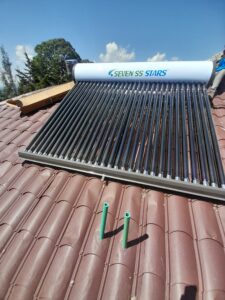How to Choose a Solar Water Heating System in Kenya

A solar water heating system uses energy from the sun to heat water for your home. Solar collectors on the solar powered water heater on your roof collect energy from the sun’s rays to heat water. It then flows to a storage tank, ready for use either early in the morning, at night or any other time.
There are many different types and configurations of solar water heaters available. It is important to select the type that is most suitable to your family size, climate, house type, roof characteristics, water quality, available space and aesthetic preferences.
Once you’ve decided you want to install solar hot water system on your roof, you have two choices to make:
- What type of solar collectors do you want in your system?
- Will you install a direct system, or indirect system?
Solar collectors
You have two options when it comes to solar collectors: flat plate collectors and evacuated tube collectors.
Flat plate collectors
They are a commonly used solar hot water technology, and have been in use for decades. They are made of an absorber plate bonded to pipes inside the panel. Absorber plates are usually made from copper or aluminum that is painted for maximum energy absorption. Their main advantage over evacuated tube models is price. Flat plate collectors are generally less expensive than evacuated tube collectors. They don’t perform well in cold weather, making them best for homeowners in warmer climates.
Evacuated tube collectors
These are a newer innovation for the solar hot water system industry, and improve on many aspects of flat plate collectors by surrounding the absorber plate with glass tubing. The vacuum inside the glass tubes acts as a powerful insulator, making evacuated tube technology perform better than flat plate collectors in colder weather. They also collect heat more evenly throughout the day, and heat water to a higher temperature.
In general, flat plate collectors and evacuated tube collectors can be compared in a similar way to polycrystalline and monocrystalline solar panels. Like polycrystalline solar panels, flat plate collectors are less expensive, but less efficient. Evacuated tube collectors are like monocrystalline solar panels. They are more expensive up front, but will save more money in the long-run due to their higher efficiency.
Direct and indirect solar water heater
You’ll need to decide between a direct and indirect setup if you choose to install one with flat-plate collectors or evacuated tubes. Direct systems heat water right from the sun, while indirect systems use a different fluid to transfer heat from your collectors before heating water.
A direct solar water heating system cycles potable water through your collectors, where it is heated by the sun and moves throughout your home. Direct solar water heating systems work well in warm climates. This is because heated water moving through pipes has less chances to lose energy when surrounded by warm air.
In an indirect system, use a non-freezing liquid to transfer heat from the sun to water in a storage tank. The sun’s thermal energy heats the fluid in the solar collectors. Then, this fluid passes through a heat exchanger in the storage tank, transferring the heat to the water. The non-freezing fluid then cycles back to the collectors.
This system tends to be more successful in the areas with extreme cold seasons, because they are more resistant to cold weather, as water is stored inside in a storage tank rather than waiting in tubing to be cycled through your home.
Solar water heating systems comparison
If you are a little bit overwhelmed by all the information above? In this section we will give a simple and concise guide to choosing a solar water heating system.
- If there are many people living in your household and you are located in a warm climate, a direct solar water heating system with evacuated tubes is probably your best option considering overall cost and efficiency.
- If you want hot weather all year round and don’t want to spend time and money on maintenance, a direct system makes the most sense.
- If you live in an area with moderate climate and don’t have a large budget, you can choose a direct system with flat-plate collectors, but keep in mind the flat-plate are not much efficient like the ones with evacuated tubes.
- Evacuated tubes collectors are gaining ground in the past years due to their high efficiency and serve homeowners as intended.
- If you live in a cold area, an indirect system is a good choice because the heat-transfer liquid, usually antifreeze, will allow operation over a wider range of temperatures.
- Warranties: just like solar photovoltaic products, solar water heater components have warranties associated with them. Make sure to understand your warranty terms before installing any solar hot water system. Higher quality solar hot water options typically come with a warranty to match
Conclusion
After reading this article, you should have a much better idea of how to choose your solar water heating system. If you are like most, you will choose among the most popular solar water heater systems in Kenya, which is direct system with evacuated tube collectors due to its high efficiency and also in most parts of the country we don’t experience extreme cold seasons and a direct system will work just fine.
Related reading: 7 Benefits of Installing Solar Water Heating Systems
At Voltmatic Energy Solutions, we can help you choose the right solar water heating system ideal for your needs, install quality components on your roof and help you enjoy the savings on power bills. You can reach directly to us via the contacts below.
Phone: 0759493610
Email: info@voltmaticenergysolutions.co.ke
